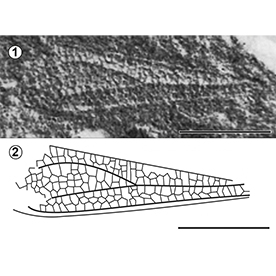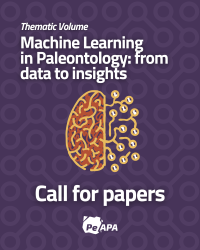IDENTITY OF MIOMOPTERA AND GLOSSELYTRODEA (INSECTA: PALAEOMANTEIDA, JURINIDA) DESCRIBED FROM THE POTRERILLOS AND LOS RASTROS FORMATIONS, UPPER TRIASSIC OF ARGENTINA
DOI:
https://doi.org/10.5710/PEAPA.23.02.2024.490Keywords:
Carnian, Cuyo-Bermejo Basins, Fossil insects, HemipteraAbstract
Upper Triassic (Carnian) Los Rastros and Potrerillos formations (Argentina) are famous for their fossil insects. Some interesting Triassic fossil insects are reviewed in this work. The present paper is devoted to four described extinct Paleozoic species from two orders, Miomoptera and Glosselytrodea. Miomina mendozina Martins-Neto & Gallego, 1999 from the Potrerillos Formation is described as Miomoptera based on a unique holotype which has not been located. After reviewing the published illustrations, we conclude that it is possibly a plant remain and not an insect wing. Miomina riojana Martins-Neto & Gallego, 2006 from the Los Rastros Formation, represents a wing fragment with a few short veins and we prefer to leave it identified as questionably assigned to the Order Miomoptera. Both fossils assigned to Glosselytrodea come from the Los Rastros Formation. Argentinoglosselytrina pulchella Martins-Neto & Gallego, 2001 represents a distinct genus and species of the glosselytrodean family Glosselytridae, redescribed herein. In contrast, Chanarelytrina nana Martins-Neto & Gallego, 2006 represents the detached clavus (anal section of a forewing) of Saaloscytina carmonae Martins-Neto et al., 2006 (Hemiptera, Scytinopteroidea, Saaloscytinidae). Argentinoglosselytrina pulchella from the Upper Triassic of Argentina represents the only specimen from an extinct order that characterized the Paleozoic, which reflects the differences between this fauna and that of Central Asia, which is richer in ancient groups. Its modified morphology suggests a possible event of origin of a high-ranked and early aborted evolutionary line.
References
Artabe, A. E., Morel, E. M., & Zamuner, A. B. (2001). El Sistema Triásico en la Argentina. Fundación Museo de La Plata “Francisco Pascasio Moreno”.
Brauckmann, C., Gallego, O. F., Hauschke, N., Martins-Neto, R. G., Groening, E., Ilger, J. M., & Lara, M. B. (2006). First Late Triassic record of a paleoentomofauna from South America (Malargüe Basin, Mendoza Province, Argentina). Acta Geologica Sinica (English edition), 84(4), 915–924.
Cabrera, A. (1928). Un segundo ortóptero del Triásico argentino. Revista Española de Entomología, 4, 371–373.
Gallego, O. F. (1997). Hallazgos de Insectos Triásicos en la Argentina. (Nota Paleontológica) Ameghiniana, 34(4), 511–516.
Lara, M. B., Bustos Escalona, E. L., Mancuso, A. C., & Arcucci, A. B. (2021). Upper Triassic hemipterans from the south-western Gondwana: taxonomical, paleobiological, and paleogeographical implications. Journal of South American Earth Sciences, 107, 103–119.
Lara, M. B., Cariglino, B., & Zavattieri, A. M. (2023). Late Paleozoic–Early Mesozoic insects: state of the art on paleoentomological studies in southern South America. Ameghiniana, 60(5), 418–449.
Martins-Neto, R. G. & Gallego, O. F. (1999). The Triassic Insect Fauna from Argentina. I. Auchenorrhyncha, Miomoptera and Ensifera. Revista Española de Paleontologia, 14(2), 191–202.
Martins-Neto, R. G. & Gallego, O. F. (2001). The Triassic Insect Fauna from Argentina. IV. Glosselytrodea and complements on Auchenorrhyncha. Acta Geológica Leopoldensia, 24(52/53), 105–114.
Martins-Neto, R. G., Brauckmann, C., Gallego, O. F., & Carmona, M. J. (2006). The Triassic insect fauna from Argentina. – Blattoptera, Glosselytrodea, Miomoptera, Auchenorrhyncha, and Coleoptera from the Los Rastros Formation (Bermejo Basin), Los Chañares locality (La Rioja Province). Clausthaler Geowissenschaften, 5, 1–9.
Martins-Neto, R. G., Gallego, O. F., & Melchor, R. N. (2003). The Triassic Insect Fauna from South America (Argentina, Brasil, and Chile): A Checklist (except Blattoptera and Coleoptera) and descriptions of new taxa. Acta Zoologica Cracoviensia, 46 (suppl. Fossil Insects), 229–256.
Martins-Neto, R. G., Gallego, O. F., & Vaz Tassi, L. (2011). The Triassic coleopteran fauna of southern South American: Morphometric variation of elytra, paleobiogeography, and a phylogenetic approach. GAEA Journal of Geociences, 7(1), 1–18.
Morel, E. M. (1994). El Triásico del Cerro Cacheuta, Mendoza (Argentina). Parte I: Geología, contenido paleoflorístico y cronoestratigrafía. Ameghiniana, 31, 161–176.
Rasnitsyn, A. P. & Aristov, D. S. (2013). New Fossil Insects (Insecta: Caloneurida, Hypoperlida, Palaeomanteida, Jurinida) from the Middle and Upper Permian of European Russia. Paleontological Journal, 47(7), 678–704.
Shcherbakov, D. E. (2008). On Permian and Triassic Entomofaunas in Connection with Biogeography and Rermo–Triassic Crisis. Paleontological Journal, 42(1), 15–31.
Shcherbakov, D. E. (2011). New and little-known families of Hemiptera Cicadomorpha from the Triassic of Central Asia—early analogs of treehoppers and planthoppers. Zootaxa, 2836, 1–26.
Stipanicic, P. N. & Marsicano, C. A. (2002). Léxico Estratigráfico de la Argentina, Volumen VIII, Triásico (Serie ‘B’ Didáctica y Complementaria, n° 26). Asociación Geológica Argentina.
Stipanicic, P. N., Herbst, R., & Bonetti, M. I. R. (1996). Floras Triásicas. Actas de la Academia Nacional de Ciencias (Córdoba), 11, 127–184.
Tillyard, R. J. (1926). Alleged Rhaetic “Crane Flies” from South America, non Diptera but Homoptera. American Journal of Sciences, 5, 265–272.
Voigt, S., Buchwitz, M., Fischer, J., Kogan, I., Moisan, P., Schneider, J. W., Spindler, F., Brosig, A., Preusse, M., Scholze, F., & Linnemann, U. (2017). Triassic life in an inland lake basin of the warm temperate biome – the Madygen Lagerstätte (southwest Kyrgyzstan, Central Asia). In N. C. Fraser, H. D. Sues (Eds.), Terrestrial Conservation Lagerstätten – Windows into the Evolution of Life on Land (pp. 65–104). Dunedin Academic Press.
Wieland, G. R. (1925). Rhaetic crane flies from South America. American Journal of Sciences, 9, 21–28.
Wieland, G. R. (1926). South American fossil insect discovery. American Journal of Sciences, Fifty Series, 12, 130–135.

Additional Files
Published
Issue
Section
License
Copyright (c) 2024 Alexandr Pavlovich Rasnitsyn, Oscar Florencio Gallego

This work is licensed under a Creative Commons Attribution-NoDerivatives 4.0 International License.
Authors retain copyright and grant the journal right of first publication with the work simultaneously licensed under a Atribución/Reconocimiento 4.0 Internacional that allows others to share the work with an acknowledgement of the work's authorship and initial publication in this journal.
















